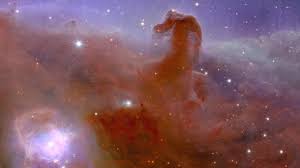BRUSSELS (AFP): The first images from Europe’s Euclid space telescope were released on Tuesday, showing a nebula resembling a horse’s head, never-before-seen distant galaxies and even “circumstantial evidence” of elusive dark matter.
Euclid blasted off in July on the world’s first-ever mission aiming to investigate the enduring cosmic mysteries of dark matter and dark energy.
It will do so partly by charting one third of the sky — encompassing a mind-boggling two billion galaxies — to create what has been billed as the most accurate 3D map of the universe ever.
After joining fellow space telescope James Webb at a stable hovering spot around 1.5 million kilometres (more than 930,000 miles) from Earth, Euclid started sending back its first observations.
European Space Agency chief Josef Aschbacher said in a statement that Euclid’s first five images were “awe-inspiring and remind us of why it is essential that we go to space to learn more about the mysteries of the universe”.
They include an image of the Horsehead Nebula and part of the famous Orion constellation, as well as spiral and “irregular” galaxies.
But Euclid project scientist Rene Laureijs told AFP that the most exciting for the team was an image of the Perseus Cluster, a massive distant collection of more than a thousand galaxies.
Lurking in the background of the cluster is more than 100,000 additional galaxies, some of which are 10 billion light years away and have never been seen before, according to the ESA.
– ‘Dark universe detective’ –
Jean-Charles Cuillandre, another scientist working on Euclid, told AFP that Euclid is different to other space telescopes because it takes in a very wide field of view, “like never before seen in the history of astronomy.”
In comparison, the Webb telescope “looks at the sky through the eye of a needle,” he said.
This wide view means it can capture such broad images extremely quickly — the five new images only took around eight hours of the telescope’s time.
Images from another 16 hours — making up a full day — will be released in January.
The ESA has dubbed Euclid its “dark universe detective,” charged with investigating why 95 percent of the universe appears to be made up of dark matter and dark energy, which we know very little about.
“Dark matter pulls galaxies together and causes them to spin more rapidly than visible matter alone can account for; dark energy is driving the accelerated expansion of the universe,” explained ESA science director Carole Mundell.
Euclid’s early images have already pointed towards “circumstantial evidence” of dark matter, according to Laureijs.
For example, he said it was “surprising” that Euclid did not spot stars trailing globular cluster NGC 6397, a collection of hundreds of thousands of stars.
“One of the theories is that there might be dark matter around the globular cluster, which keeps all the stars together,” Laureijs said.
– Walk back in time –
By capturing light that has taken 10 billion years to reach Earth’s vicinity, Euclid also hopes to better understand how dark energy has driven the universe’s expansion since the Big Bang 13.8 billion years ago.
Once Euclid has collected enough data, the scientists plan to plot out a 3D map — the third dimension being time.
Laureijs said the map would allow people to “walk through a part of the sky and go 10 billion years back in time”.
But that will have to wait for future data releases over the planned six-year mission.
It has not been all smooth sailing for Euclid.
When the scientists first started their observations, they found that cosmic rays were disturbing the telescope’s extremely sensitive fine guidance sensor.
The spacecraft’s software had an algorithm that was “fooled” by the cosmic rays, Laureijs said.
However the team on the ground managed to upload a new algorithm to the spacecraft. “Now it works flawlessly,” Laureijs said.
There was also a problem with sunlight reflecting off a thruster boom which required rotating the telescope a little, he added.
A series of scientific papers analysing what is in the five new images will be published soon, according to the ESA.
Glimpses of the ‘galactic zoo’: The five new Euclid images
The first images from Europe’s Euclid space telescope released Tuesday range from a well-known nebula to never-before-seen galaxies 10 billion light years away, illustrating its wide-lens view of the universe.
Here are the five images — described by Euclid scientist Jean-Charles Cuillandre as “a range of objects from the galactic zoo in terms of diversity, colours and shapes” — starting with the closest to Earth and moving out into the cosmos.
– Horsehead Nebula –
A giant red horse seems to rear its head against a background of swirling stars, some still being formed in a stellar nursery.
The Horsehead Nebula — also known as Barnard 33 — is 1,375 light years away.
The horse’s head is in fact dark clouds in front of ultraviolet radiation coming from Sigma Orionis, which is the eastern star on the belt of the Orion constellation.
The Horsehead Nebula has been observed before, but the European Space Agency’s Euclid telescope is the first to deliver such a complete view in just an hour, thanks to its wide lens.
Scientists hope that by scouring through Euclid’s observations of the nebula, they will find previously unseen Jupiter-sized planets, as well as stars still in their infancy.
– Globular cluster NGC 6397 –
At 7,800 light years away — but still in our Milky Way galaxy — this cluster is a collection of hundreds of thousands of stars bound together by gravity.
“Currently no other telescope than Euclid can observe the entire globular cluster and at the same time distinguish its faint stellar members in the outer regions from other cosmic sources,” Euclid Consortium scientist Davide Massari said in a statement.
Scientists hope to use Euclid’s observations to spot stars trailing such globular clusters as they travel through our galaxy.
“The surprising thing is that we don’t see these stars trailing,” Euclid project scientist Rene Laureijs told AFP.
“One of the theories is that there might be dark matter around the globular cluster, which keeps all the stars together,” he said.
The ESA hopes Euclid will shed more light on dark matter and dark energy, which are thought to make up 95 percent of the universe but remain shrouded in mystery.
– An irregular galaxy –
Not all galaxies are pretty spirals like our own. Images of the irregular dwarf galaxy NGC 6822, some 1.6 million light years from Earth, have been captured before, including by the James Webb Space Telescope.
However Euclid is the first to be able to capture the whole galaxy in barely an hour.
As is often the case in the early universe, this galaxy’s stars are low on metal, and the scientists hope that analysing them will shed light on how galaxies evolve.
– The ‘hidden galaxy’ –
The spiral galaxy IC 342 earned the nickname the “hidden galaxy” because it can be difficult to spot behind the disc of our own Milky Way.
It is relatively nearby — in galactic terms at least — some 11 million light years from Earth.
However Euclid’s infrared vision was able to peer through the dust to spot never-before-seen globular clusters, ESA said.
– Perseus Cluster –
ESA described this image as “a revolution for astronomy”.
It depicts the Perseus Cluster, which contains a thousand galaxies some 240 million light years away.
But in the background there are more than 100,000 additional galaxies, some 10 billion light years away, ESA said. Many of those distant galaxies have never been spotted before.
Laureijs said it was “very exciting” when the team saw the image for the first time and found low-level light coming not from the cluster, but from stars left over from collisions between galaxies.
That these stars were not being pulled back into the galaxies could suggest the presence of dark matter, he said.
Laureijs emphasised that this remains “circumstantial evidence,” and that future research could reveal more about dark matter’s distribution throughout the universe.







